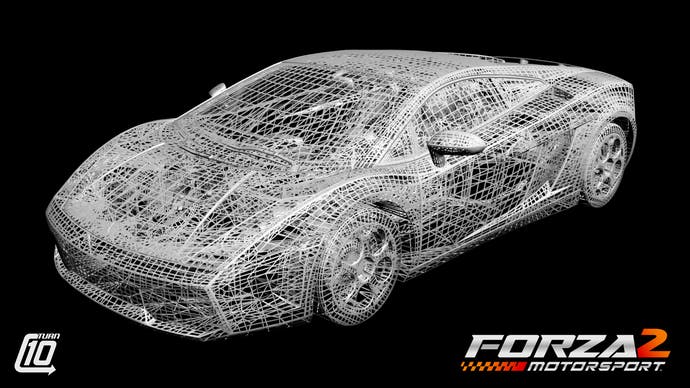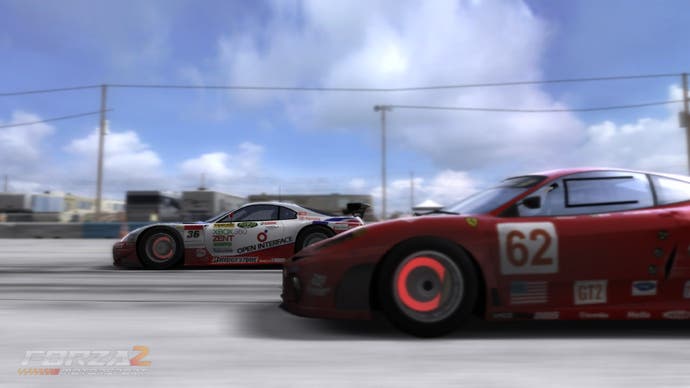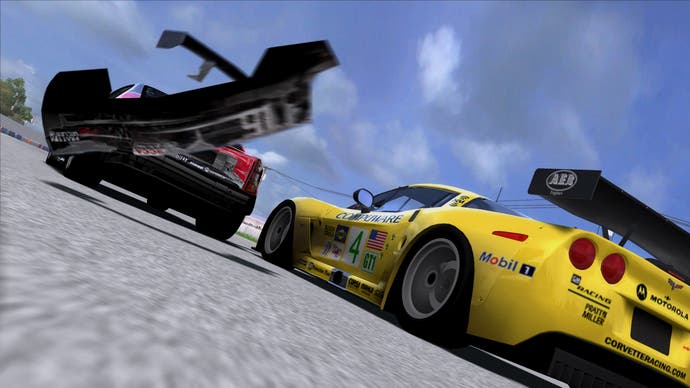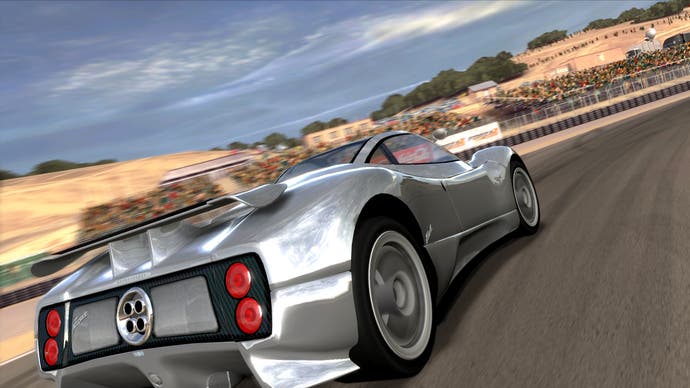Forza Motorsport 2
Bodyshop Pro.
The night before going to see Forza Motorsport 2 I ran nine miles. It was fairly tough. But not, as I was to discover, as tough as the all-over body and cardio-vascular workout you get from driving for 20 minutes round the UK's biggest indoor karting track, which is where Microsoft decided to show off the game to a bunch of games journalists. Fortunately, Forza 2 is rather more forgiving, in spite of its hardcore simulation credentials. In fact, speaking in one of the raceway's swanky corporate-hospitality meeting rooms, Game Director Dan Greenawalt declares: "The goal of this game is to really turn gamers into car lovers and turn car lovers into gamers and create a really big community that gets excited about games and excited about cars."
That community aspect cuts right to the core of most of the game's new features and improvements, but the most obvious area where Forza 2 excels is in its physics model. Indeed, in the bid to scale next-generation heights of simulation accuracy, the team put in three months on the tyre system alone. That's the amount of time it took to accurately model the effects of pressure, wear and heat (on the inside and outside of the tyre), as well as looking into load sensitivity - which is, apparently, the efficiency of the tyre under an increasing load. It's not something you'd usually expect in a motor racing videogame, and it required the use of proprietary real-world data from the likes of Yokohama, Toyo, Michelin and Bridgestone.
All of the tracks have also had a suitably next-gen, high-definition makeover, with the development team using GPS and aerial satellite data and some 3,000 photos to recreate each track. They even recorded air pressure and temperature to make sure their simulation will be rigorously accurate. But the fruits of these labours are best illustrated in some of the new tracks, like Sebring, which is an ex-airfield constructed out of mismatched slabs of concrete. In the real world, this surface puts considerable stress on a car (and a driver's kidneys, apparently). And in the game, too, thanks to an underlying physics model that runs its calculations at 360 per second (in contrast with most other racing games: they employ a model that runs at 60 per second, which wouldn't pick up the closely-spaced bumps at high speeds).

The physics also get a workout if you crash. Bowing to pressure from fans of the original game, Forza 2 will, unlike the original, feature full simulation damage - so if you drive into a wall, the chances are you won't be driving anywhere afterwards. And the game's AI Drivatar system has also been improved, with other drivers exhibiting a more pronounced sense of personality (and the top driver, M. Rossi, regularly frustrating testers with his check-braking, bumping, blocking and just general skulduggery).
What all this advanced physics modelling means is that there is plenty of opportunity to play around with real-world cars in ways they weren't meant to be played with. "What this game is in many ways is a motor sports sandbox where you can go and play with things and trust that we've done the math, that we've done the research to say this is really possible," says Greenawalt. Which leads, of course, into playing with the game's performance upgrade options.
As Greenawalt puts it, "your first car is kind of like your first love." And so while Forza 2 will obviously include plenty of scope for the automotive equivalent of getting off with a superhot model, there's also plenty of scope for a more long-term romance if you're looking for personality. Which is a laboured way of saying that the cars in the game range from the likes of the Honda Civic Type-R to custom-built race cars. And while most motor racing games these days allow you to customise your vehicle to some extent, what sets Forza 2 apart is the scale and range of its upgrade options. In the original Forza there were 20 different types of upgrades, each with their own sub-categories. Forza 2, however, boasts 50 per cent more, including ten different types of upgrade devoted to the engine alone.

Greenawalt proceeded to demonstrate these upgrades by taking the aforementioned Honda Civic Type-R and adding a new intake to push it from class D to C, before adding cams and valves to push it into class B, the natural habitat of the likes of the Audi RS 4. "If you had a Honda Civic Type R and you were to weight-reduce it down to say 900kilos and put it up to 600 horsepower with racing slicks for the downforce, it should be able to compete against Enzos and things like that," he says. And of course you can do all that because they've done the math. Or maths, as we like to call it over here.
One upshot of this extensive upgrade system is that it will turn gamers into car lovers by educating them about different aspects of car design ("What does a conical air filter do?" asks Greenawalt. "Provides isolation from hot air to improve engine performance," says the Internet). Sunday drivers/mere mortals will also be helped out by a full complement of driving assists, from a visible racing line, through ABS to being able to set the level of car damage. And the game's achievements should be in reach of even learner drivers, since a lot of them will reward players for collecting new cars and so on.

Gamers who aren't already car lovers are most likely to be converted, though, by an extensive suite of cosmetic customisation options. As anyone who's played the original Forza online will recognise, it's an important aspect of the game - so much so that some people went to the trouble of painting the likes of the Mona Lisa on the side of their car using the first game's limited paint job options. The new system expands them to allow you to create different layers and manipulate them with some fairly sophisticated tools. Whereas there were 600 layers in the original, that's been increased to 4,000 for the sequel, for example, and they can be grouped so you can manipulate multiple layers and create even more detailed renaissance masterpieces. If you're so inclined.
If you are so inclined, you'll also welcome the new photo feature. Whereas, previously, budding Leonardos were restricted to taking photographs of their TV screens and uploading them to the internet in a blurry bid to show off their handiwork, this new function makes it much easier. Now it's possible to take an in-game picture of your car at pretty much any point in the game, and it'll be uploaded to forzamotorsport.net automatically (and while that's impressive enough, it's also pretty neat just to be able to zoom around to check the fine detail on the textures).

Budding Michelangelos will also be able to sell their masterpieces online for in-game credits in one of the game's other new features: the auction house. Indeed the online component of the game is another area that the development team has focused on at length. One improvement, for example, will see the end of the dominance of supercars like the F355 or CRX. That dominance arose because the original game used a linear car classification formula. For the sequel, one of the game's AI programmers created a neural net to test the performance of all the game's different permutations and combinations of car components - taking 48 hours to run. Consequently, the car classification system should be much less open to the dominance of any particular car model - and if the system doesn't work as well as expected, the programmers have left a back door to continue tweaking after release.
As for how the game actually plays, well your humble correspondent was too terrified by the quality of the competition to check out the three-screen setup in the corner of the room (one chap had even bought his own helmet for the karting). Even playing the game with the Xbox 360's wireless steering wheel initially proved a bit tricky, though obviously this will be the long-term choice of any serious Forza fans. Ultimately though, this is the sort of driving realism that fans of the first game will find familiar. Which means it'll take a little while to adjust to if you've been busy smashing your opponents off the road in Burnout, or powersliding around Ridge Racer. But it also means that it'll have the depth to sustain your interest right the way through the 70-hour single-player career.
And then it was time to put everything that I'd learned in the game into practice on the UK's largest indoor kart track. Where, after blistering my hands and losing about 90 per cent of my bodyweight in sweat I came a rather undignified 9th. I'd blame it on a dodgy kart, but all the other drivers seemed to be doing that. Maybe I'll stick to painting.


